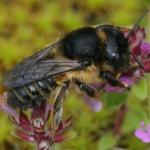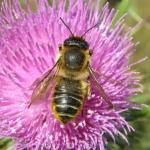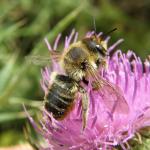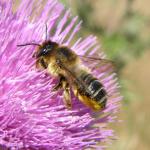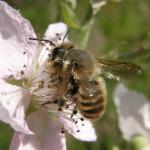Megachile flaviventris SCHENCK 1853; Megachile fulvescens SMITH 1853; Phyllotoma manicata DUMERIL 1860; Megachile kashgarensis COCKERELL 1913
Widely distributed and locally common in southern Britain, the range extending northwards to Caernarvonshire, Lancashire and Norfolk. Also known from the Isle of Man (Nelson, 1981) and the larger Channel Islands (Richards, 1979). In Ireland it has been recorded only from Wicklow and Wexford. The species occurs throughout most of Europe, the range extending east to India.
This bee is not regarded as being scarce or threatened.
As the species name implies, this handsome leaf-cutter bee is mainly found on the coast, especially where there is light, sandy soil. Other populations occur on lowland heaths and, more rarely, on chalk grassland.
Univoltine; early June to mid August.
The nest burrows are excavated in the soil, although a nest was found in August 1944 in a wall at Croyde, Devon by O.W. Richards (a specimen bred from the nest is in The Natural History Museum, London). Individual cells are constructed from neatly cut sections of green leaves obtained from various plants (e.g. sallow (Salix sp.) and hound's-tongue (Cynoglossum officinale), round pieces being used for the end walls, oval ones for the side walls. The cell walls are, as in most Megachile species, multi-layered. Nests have been described and the cells figured by Walrecht (1958) and Grandi (1961).
Mignonette (Reseda sp.), heath (Erica sp.), bramble (Rubus fruticosus agg.), restharrow (Ononis sp.), common bird's-foot-trefoil (Lotus corniculatus), greater bird's-foot-trefoil (Lotus pedunculatus), sea-holly (Eryngium maritimum), hogweed (Heracleum sphondylium), viper's-bugloss (Echium vulgare), nettle-leaved bellflower (Campanula trachelium), spear thistle (Cirsium vulgare), common knapweed (Centaurea nigra) and ragwort (Senecio species).
Coelioxys conoidea is a cleptoparasite of this bee. A large race of C. mandibularis may be an additional cleptoparasite in Glamorgan (Hallett, 1928) and Lancashire, but this requires confirmation, preferably with specimens reared from known M. maritima nests.
Profile written:
Proofed: January 2012


